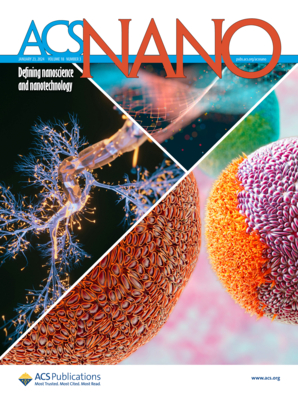Hierarchical Nanocellulose Photonic Design for Synergistic Colored Radiative Cooling
IF 16
1区 材料科学
Q1 CHEMISTRY, MULTIDISCIPLINARY
引用次数: 0
Abstract
Daytime radiative cooling (DRC) materials offer a sustainable, pollution-free passive cooling solution. Traditional DRC materials are usually white to maximize solar reflectance, but applications like textiles and buildings need more aesthetic options. Unfortunately, colorizing DRC materials often reduce cooling efficiency due to colorant sunlight absorption. Thus, this study reports a hierarchical photonic structure consisting of photoluminescent scatterer networks and a nanocellulose cholesteric structure. This design effectively addresses the trade-off between cooling efficiency and coloration, achieving enhanced cooling through synergistic all-day coloration. Sustainable nanocellulose with highly ordered cholesteric structures selectively reflects visible wavelengths, generating structural color and high mid-infrared (MIR) emission. The photoluminescent scatterer networks enhance reflectance and convert absorbed light into photoluminescent emission, further promoting cooling. This synergistic photonic interaction results in a significantly enhanced high reflectance of 92%, high MIR emissivity of >90%, stable and tunable structural color appearance, and hours-long afterglow photoluminescence. Consequently, a subambient cooling of up to 11.3 °C under sunlight is attainable, accompanied by the ability to produce programmable structural color and photoluminescent patterns for daytime and nighttime visibility. The enhanced cooling efficiency achieved through the synergistic interplay of four optical mechanisms from the UV to MIR region offers a promising design paradigm for other DRC materials.

协同有色辐射冷却的分层纳米纤维素光子设计
日间辐射冷却(DRC)材料提供了一种可持续的、无污染的被动冷却解决方案。传统的DRC材料通常是白色的,以最大限度地提高太阳反射率,但纺织品和建筑等应用需要更多的美学选择。不幸的是,由于着色剂对阳光的吸收,着色DRC材料通常会降低冷却效率。因此,本研究报告了一个由光致发光散射体网络和纳米纤维素胆甾化结构组成的分层光子结构。这种设计有效地解决了冷却效率和颜色之间的权衡,通过全天候的协同着色来实现增强的冷却。具有高度有序胆甾体结构的可持续纳米纤维素选择性地反射可见光,产生结构色和高中红外(MIR)发射。光致发光散射体网络增强了反射率,将吸收的光转化为光致发光,进一步促进冷却。这种协同光子相互作用的结果显著增强了92%的高反射率,高达90%的高MIR发射率,稳定可调的结构颜色外观,以及长达数小时的余辉光致发光。因此,在阳光下可达到11.3°C的亚环境冷却,同时能够产生可编程的结构颜色和光致发光模式,以适应白天和夜间的能见度。通过从UV到MIR区域的四种光学机制的协同相互作用实现的增强冷却效率为其他DRC材料提供了一个有前途的设计范例。
本文章由计算机程序翻译,如有差异,请以英文原文为准。
求助全文
约1分钟内获得全文
求助全文
来源期刊

ACS Nano
工程技术-材料科学:综合
CiteScore
26.00
自引率
4.10%
发文量
1627
审稿时长
1.7 months
期刊介绍:
ACS Nano, published monthly, serves as an international forum for comprehensive articles on nanoscience and nanotechnology research at the intersections of chemistry, biology, materials science, physics, and engineering. The journal fosters communication among scientists in these communities, facilitating collaboration, new research opportunities, and advancements through discoveries. ACS Nano covers synthesis, assembly, characterization, theory, and simulation of nanostructures, nanobiotechnology, nanofabrication, methods and tools for nanoscience and nanotechnology, and self- and directed-assembly. Alongside original research articles, it offers thorough reviews, perspectives on cutting-edge research, and discussions envisioning the future of nanoscience and nanotechnology.
 求助内容:
求助内容: 应助结果提醒方式:
应助结果提醒方式:


